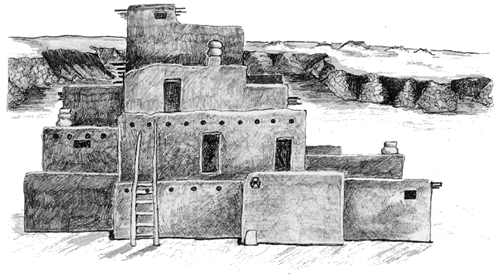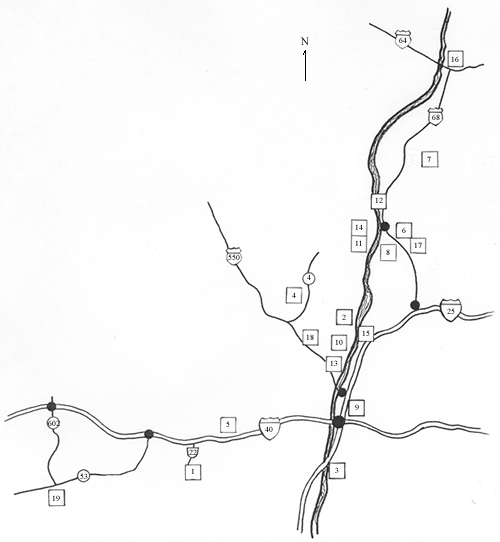“Pueblo” is the Spanish word for village. Spanish explorers used the word “pueblo” to describe both the permanent residential structures and the people living in these communities throughout the middle Rio Grande Valley. When the Spanish arrived in 1540, there were possibly more than 100 pueblos located along the Rio Grande Valley, from northern Taos Pueblo to southern Isleta Pueblo. Today there are 19 pueblos in New Mexico, each with its own government but sharing a common prehistory and culture.
Pueblo History
Contemporary Pueblo people are descendants of Ancestral Puebloans who lived throughout the Four Corners area. Pueblos can trace their history from pre-Columbian times, and in most cases they still occupy the land and villages of their ancestors. Today’s Pueblo people object to the use of “Anasazi,” which is a Navajo word meaning “ancient enemies” or “enemy ancestors.” “Ancestral Puebloans” is a more accurate and respectful term when referring to Pueblo ancestors.
Archeologists talk about the Pueblo Period beginning over 600 years ago, when nomadic hunters and gatherers began settling and raising crops. By about A.D. 1300, many of the major river valleys in New Mexico were supporting large Pueblo communities that depended on agriculture to maintain their growing populations.
When Spanish explorers began arriving in New Mexico in 1540, they found a thriving Pueblo culture, rich in tradition and interconnected by trade and family ties. As time went on, confrontations arose between Spanish colonists and the Puebloans. In 1680 the Pueblo Revolt forced the Europeans to leave New Mexico until 1692, when the Spanish reoccupied the middle Rio Grande Valley. Since that time, Spanish and Pueblo cultures have merged to form a blend of spirituality and tradition.
Pueblo Etiquette
Visiting area pueblos is a good way to experience cultures and traditions that have existed in the region for more than 600 years. Keep the following suggestions in mind to avoid any misunderstandings or violations of customs while visiting a pueblo, and enjoy your pueblo experience.
General: Each pueblo operates under its own government and establishes all rules and regulations for its own individual village. Please respect and abide by the laws and wishes for each specific pueblo you are visiting. Although most pueblos are open to the public during daylight hours, the homes are private and should not be entered without an invitation. Kivas and graveyards are NOT to be entered by non-Pueblo people. Stay off walls and other structures; some are several hundred years old and can be damaged easily. Please stay in the immediate village area and do not wander. Removing any artifacts or objects, such as pieces of broken pottery or feathers, is not allowed. No pets, please; village dogs generally are docile around people, but can be very aggressive toward animals from the outside. Drive slowly and obey posted speed limits at all times; city speeds are not appropriate. There are many elders, children, and animals in the villages. Park in designated areas. Alcohol, weapons, and drugs are not tolerated.
Ceremonial: On feast days, enter a Pueblo home as you would any other - BY INVITATION ONLY. It is courteous to accept an invitation to eat, but do not linger at the table because host will be serving many guests throughout the day. Thank your host and family, but a payment or tip is not appropriate. All Pueblo dances are religious ceremonies, not staged performances. Do not stand in front of elders and participants or block their view of the plaza. Do not interrupt non-dance participants’ concentration by asking questions, talking, or waving to friends. Do not approach to talk to the dancers as they are entering, leaving, or resting near the kiva. Applauding after dances is not appropriate. Please keep your children with you at all times, and ensure that all of you observe ceremonies with respect and quiet attention.
Photography/Artwork/Audio Recording: Each pueblo has its own regulations regarding photography, video, artwork, and audio recording. Obtain official permits upon entering the pueblo. All permits are intended for personal use only. There are special fees for commercial use; please check first. A permit does not grant you the right to take photos or make sketches of an individual without asking permission first. If a pueblo allows photography of a ceremony, photograph in an unobtrusive manner. Never enter a dance area, block the entrance or path of dancers and singers, or obstruct the view of other visitors. Some pueblos forbid photos of kivas, cemeteries, and church interiors. Please follow all regulations; if not, your film, camera, and/or artwork may be confiscated or, worse, you could be expelled from the pueblo, fined, or prosecuted.
Remember, all pueblos are sovereign nations that are administered by tribal governments. Failure to abide by guidelines could result in expulsion from the pueblo, a possible fine and/or legal action, and possible closure of a pueblo to all visitors.
Pueblo Locations
Several pueblos are located near the Albuquerque metropolitan area. To the north, Sandia, San Felipe, Santo Domingo, and Cochiti Pueblos are located between Albuquerque and Santa Fe. To the northwest are Zia, Santa Ana, and Jemez Pueblos. West of Albuquerque are Acoma, Laguna, and Zuni Pueblos. South on I-25 is Isleta Pueblo. The remainder of the pueblos are located north of Santa Fe and are within a few hours drive of Petroglyph National Monument (see regional map). It is recommended that you call before traveling to any pueblo to make certain it is open for visitation.
1. Acoma Pueblo
2. Cochiti Pueblo
3. Isleta Pueblo
4. Jemez Pueblo
5. Laguna Pueblo
6. Nambe Pueblo
7. Picuris Pueblo
8. Pojoaque Pueblo
9. Sandia Pueblo
10. San Felipe Pueblo
11. San Ildefonso Pueblo
12. San Juan Pueblo
13. Santa Ana Pueblo
14. Santa Clara Pueblo
15. Santo Domingo Pueblo
16. Taos Pueblo
17. Tesuque Pueblo
18. Zia Pueblo
19. Zuni Pueblo
Additional Information is available at www.indianpueblo.org


